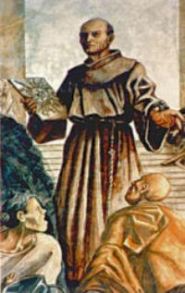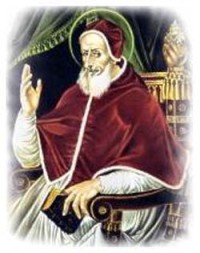The Rosary is Standardized
Additions to the Rosary
 During the 14th century, Christians began to invoke the Holy Name of 'Jesus' at the end of the early 'Hail Mary' prayer. In the early 15th century, a great preacher of the Holy Name, the Italian Saint Bernardine of Siena, also encouraged his listeners to add 'Jesus' to the then end of the 'Hail Mary'. This practice soon spread from Italy to the rest of Europe. During the 14th century, Christians began to invoke the Holy Name of 'Jesus' at the end of the early 'Hail Mary' prayer. In the early 15th century, a great preacher of the Holy Name, the Italian Saint Bernardine of Siena, also encouraged his listeners to add 'Jesus' to the then end of the 'Hail Mary'. This practice soon spread from Italy to the rest of Europe.
Around the year 1500, the popular exhortation ‘Holy Mary, Mother of God, pray for us sinners, now and at the hour of our death, Amen’ was added, completing the ‘Hail Mary’ that we recite today. In fact, a medieval book called The Splendour of the Rosary, by a Father Thurston, notes that "St. Bernardine of Siena was possibly the first person to add this second half" to the 'Hail Mary'.
Also added to the Rosary in the 15th century was the ‘Our Father’ or 'Lord's Prayer' given to us by Jesus Himself (see Matthew 6:9-13).
Next added to the Rosary prayers was the beautiful medieval prayer ‘Salve Regina’, known today as the ‘Hail Holy Queen’, which was composed in the 11th century.
Then the ‘The Apostle’s Creed’ - which dated back to the 4th century - and the Latin crucifix were added to the Rosary.
Over the centuries, people prayed the Rosary using an ever-increasing array of Mysteries from the lives of Jesus and Mary, until they numbered as many as 50 per standard rosary - one for each ‘Hail Mary’! However, by the late 15th century these had been reduced to 5 mysteries per rosary – one for each decade.
 Dominican Rosary Becomes Standard
Dominican Rosary Becomes Standard
Then in 1569, the Dominican Rosary of 15
Mysteries divided into 3 sets of 5 (Joyful,
Sorrowful and Glorious) was officially
sanctioned by the Church. This came in
the form of the Papal Bull 'Consueverent
Romani Pontifices' issued by Pope Saint
Pius V, himself a former Dominican monk.
In this writing, St. Pius V encouraged and
admonished all the faithful to pray the
Rosary as a proven antedote to heresy.
This pope, as have his successors, insisted
that meditation on each of the redemptive
Mysteries be an integral part of the Rosary
prayer. In fact, the indulgences he
attached to the Rosary for those who prayed it depended as much on the meditations of these Mysteries, as on the recitation of the prayers!
Finally, the ‘Glory Be’, a hymn of praise to the Trinity which was traditionally prayed after each Psalm in the Divine Office, was added after each decade of 'Hail Mary's, and probably popularized most by St. Louis de Montfort.
|